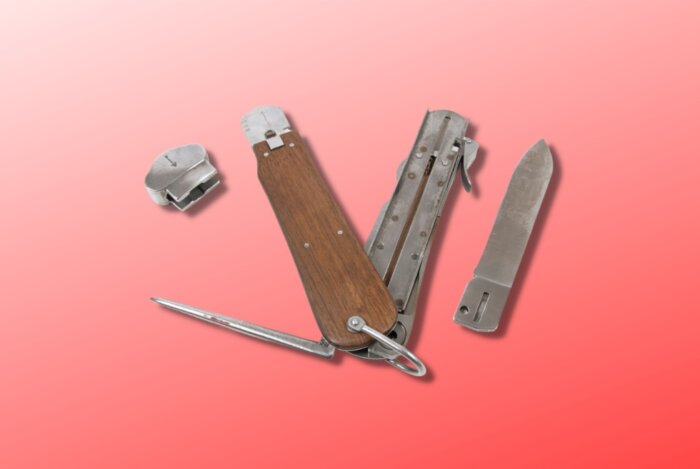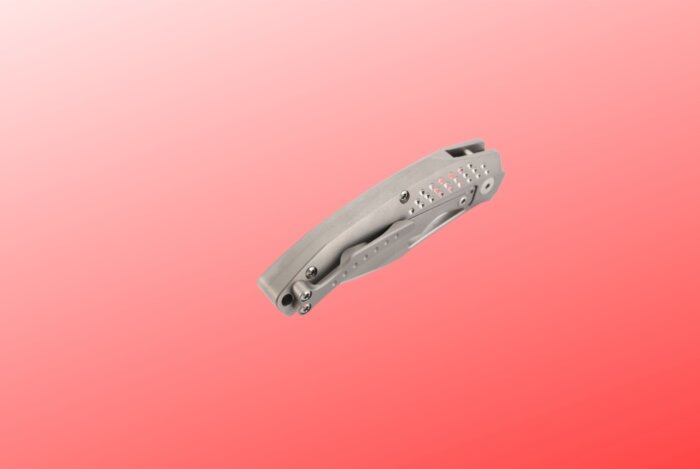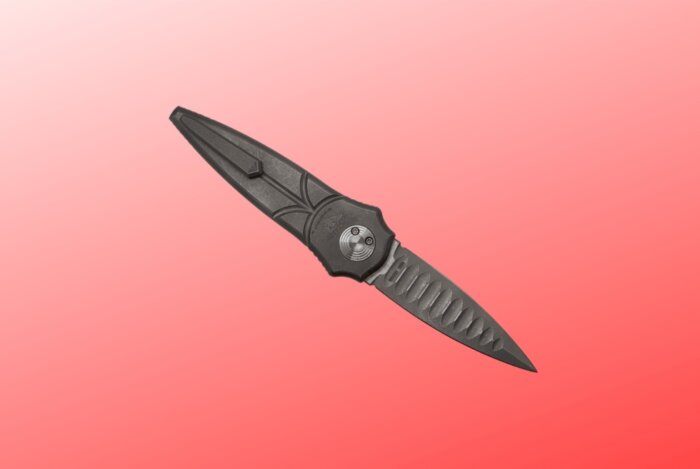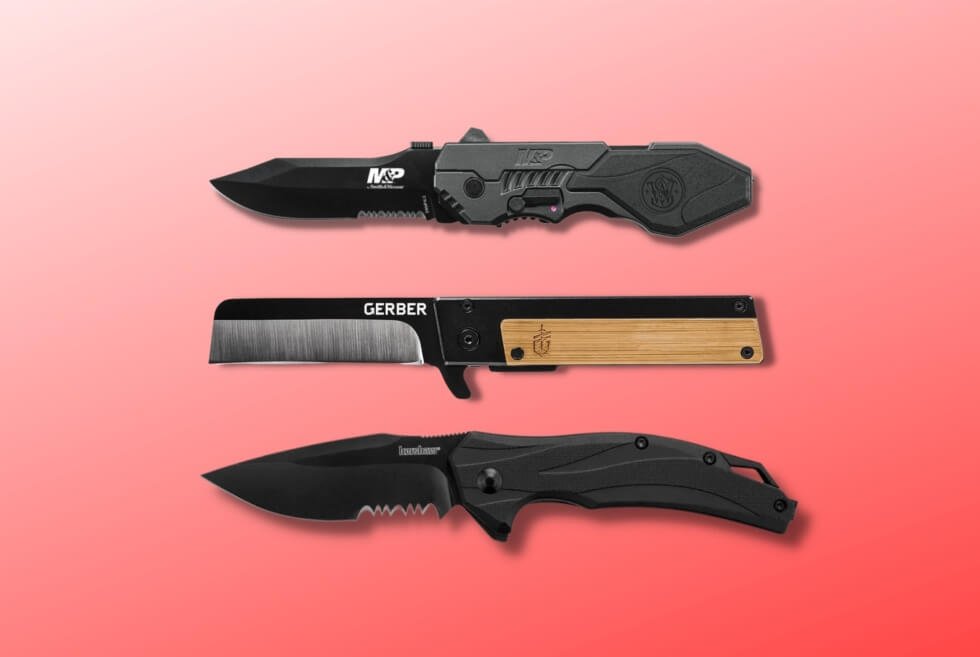Looking for an ultra-handy, instantly accessible knife to add to your EDC loadout? Give gravity knives a try!
Gravity knives are as portable as folding blade knives, but they eliminate the hassle of trying to open the knife one-handed. In fact, they require no effort at all to open—gravity does all the work for you.
You’ll find that they’re some of the most practical, convenient tools to carry around, able to deploy in a literal second and sturdy enough to be used for all your daily tasks.
Below, we’ll take a much closer look at what gravity knives are, how they work, the legality of carrying/using them, and what to look for when choosing a gravity knife. We’ve also collected an assortment of the best gravity knives on the market for your needs.
By the end of this post, you’ll know everything necessary to find and purchase the best tool for your loadout.
Gravity Knives 101
What is a Gravity Knife?
A gravity knife is a knife built with a mechanism that uses gravity to extend/open the blade.
Take a look at this video to see how it works:
You see? When you tilt the knife downward, gravity slides the blade out from within its housing, extending it. When it comes time to sheath the knife, you simply tilt it upward and let gravity do its work.
One common hallmark of gravity knives is a locking clip or holder that keeps the blade securely housed within the knife’s body. That way, the knife won’t deploy when it’s in your pocket or sitting on your tool belt. Only when you manually release the locking clip or holder (like he did in the video when “opening” the handle) is the blade free to slide out. Once the blade is extended, the clip or mechanism locks in place behind it, ensuring it remains firmly fixed in place while you use it.
Typically, the blade can be deployed faster with a flick of the wrist, once the locking clip/holder is removed. That way, it’s instantly accessible and easy to use in a seconds, without having to fumble with some complex mechanism or push open the knife with your thumb (like many EDC folding knives).
The History of Gravity Knives
Gravity knives originated in Germany during World War II. Luftwaffe pilots needed a knife that could be easily deployed one-handed to cut their parachute straps if they found themselves caught or tangled. The knife had to also be useful for a combat weapon. German knife-makers crafted the Fliegerkappmesser, which translates into “Flier’s folding knife”. The knife was also nicknamed the Luftwaffe Fallschirmjäger-Messer, or “Luftwaffe Paratrooper’s gravity knife”.
The knife was adopted by the U.S. during World War II, and was brought back to the U.S. after the war. Over the following decades, it became popular in the U.S., along with switchblades and other easy-deployed knives.
Are Gravity Knives Legal?
This is where things get a bit messy.
In the UK, you are legally allowed to carry a non-locking pocket knife with a blade up to 3 inches long. To carry a longer knife, you will need a “valid reason”, such as using it for work, transporting a blade to/from work, or it’s used for religious purposes (such as the Sikh kirpan blades).
In Canada, however, gravity knives are prohibited by laws, just like switchblades. As the Canadian Air Transport Security Authority website states, “Any knife that has a blade that opens automatically by gravity, by centrifugal force, or by hand pressure applied to a button, spring or other device in or attached to the handle of the knife (butterfly knives, switchblades, etc.) is a prohibited item and is considered an illegal item under the Criminal Code of Canada.”
During the 1950s and 1960s, gravity knives, butterfly knives, and switchblades started to get a bad reputation in the U.S. due to their use by criminals and gangsters. They were subsequently banned in most American states, and many states still consider them “deadly weapons” along with handguns.
However, in 2019, a federal district court struck down New York’s statue that banned gravity knives, and many states around the country followed suit. Currently, the only state where gravity knives are explicitly banned is Delaware. In Maryland, it’s legal to own a gravity knife, but it’s illegal to both open carry and conceal carry the blade. North Dakota and West Virginia consider the concealed carry of gravity knives to be illegal.
In the rest of the American states, however, gravity knives are largely legal, though it’s a good idea to research more thoroughly your state and city’s local knife laws before buying and carrying one (either openly or concealed).
Now that we know what a gravity knife is, where it comes from, and whether it’s legal, time to take a much closer look at the knives themselves. These are handy, reliable tools that will serve you well (provided you live in a state our country where you’re allowed to own/carry one).
Make sure to keep reading all the way to the end for our buying guide section!
The 10 Best Gravity Knives
(Note: On this list, you’ll find both gravity knives as described above and gravity-assisted knives, which feature an integrated opening button/knob but open more easily with gravity. Give them a flick of the wrist and they’ll do the job just like a gravity knife!)
Contents
- The 10 Best Gravity Knives
- FALLSCHIRMJÄGER GRAVITY KNIFE
- Reate Knives EXO Gravity Knife
- Paragon Warlock Folding Knife Black Sorcerer
- Roberto Ottonello Gravity Knife
- John Gray Custom Gravitron
- Smith & Wesson SWMP4LS
- Kershaw Clash Pocket Knife
- Niwaki Blue Steel Higonokami Folding Knife
- KIZER Tactical Folding Knives S35VN Blade
- Gerber QUADRANT

FALLSCHIRMJÄGER GRAVITY KNIFE
This isn’t so much your “everyday knife” as it is an accurate replica of the WWII knives that gave birth to what we know as the gravity knife today. Modeled after the German Fliegerkappmesser, it’s built with a blade that slides in and out of the handle, locked in place (either extended or stored in the handle) using a finger-locking mechanism set into the knife’s body. There is no spring to assist in its opening; simply unlock it, tilt it downward, and the knife will extend, ready to put to work. When the time comes to close it, open the latch once more and tilt it up. Painless and beautifully easy (with a bit of practice).
The wooden handle looks beautiful and has a bit of “retro” flair that makes it appear like the classic tool from WWII, and each is marked with a unique serial number. You won’t find a more accurate reproduction of the classic tool anywhere, and though the look is old, the design is all new, with good-quality steel and upgrades to the function that make it highly effective in this modern day and age.
Specs
- Blade Length: 4 inches
- Steel: Unspecified grade steel
- Handle: Unspecified wood

Reate Knives EXO Gravity Knife
Reate Knives is a manufacturer that can custom-make a knife the way you want it. Not only can you choose your own knife point, but you get to select the blade type that suits you and the design you like. Though most of their knives are folders, you can customize your own knife to use a gravity-opening mechanism instead. This will definitely raise the price of the custom work, but it’s well worth the expense for a high-quality, cutting-edge gravity knife.
One of the most popular models is the Reate EXO, which features a titanium exoskeleton (with micarta handle) that houses the gravity-opening mechanism. The blade itself is quality ELMAX stainless steel and at 3.75 inches long, is long enough to be a versatile and practical tool to carry around anywhere you go.
Specs
- Blade Length: 3.75 inches
- Steel: ELMAX
- Handle: Titanium and Micarta

Paragon Warlock Folding Knife Black Sorcerer
The Paragon Warlock looks and feels a bit like a switchblade, using a double push-button opener to give you access to the blade (with the help of gravity) in its housing within the handle. Pushing on the button opens the handle, and a flick of the wrist will snap the blade out. It will take a bit of practice to get the movement just right for smooth deployment, but once you master it, you’ll feel like a total badass.
The blade is just under 4 inches long, made from sturdy CPM S30V steel. The dagger point and two sharp edges are highly suited to cutting and slicing tasks. Take this knife hunting, fishing, or camping with you, and it will serve you well.
Specs
- Blade Length: 3.875 inches
- Steel: CPM S30V
- Handle: Aluminum

Roberto Ottonello Gravity Knife
Gravity knives are not easy to come by, so it should be no surprise that the higher-end offerings—like these gorgeous knives by Roberto Ottonello—are often sold out or only available in limited quantity. But if you’re lucky enough to get your hands on one, you’ll agree that they’re true works of art.
The Roberto Ottonello Gravity Knife is made from N690 Steel, meaning it’s tough, rugged, and corrosion-resistant. Weighing just 89 grams and with a blade length of 2.75 inches, it’s small and light enough to fit in any pocket, pouch, or backpack. The handle is also made of the same steel as the blade, with a sturdy housing that can more than withstand all your daily use.
Specs
- Blade Length: 2.75 inches
- Steel: N690
- Handle: N690 steel
John Gray Custom Gravitron
John Gray knives offers a wide assortment of EDC knives, all of which are fully custom-made and made to order. They will definitely be a splurge, priced higher than many of the other options on our list, but you can trust that the end product will be well worth the cost.
The John Gray Custom Gravitron features a precision-machined tumbled aluminum handle with a built-in blade that’s activated at the push of a button. When the button is pressed, the locking mechanism is released and you can extend the blade using gravity alone. The medium-length blade comes with a tanto point and is forged from ELMAX steel, and it’s heavy enough that you’ll feel the quality and durability every time you hold it.
Specs
- Blade Length: 3.625 inches
- Steel: ELMAX
- Handle: Aluminum
Smith & Wesson SWMP4LS
The Smith & Wesson SWMP4LS isn’t a proper gravity knife; instead, it’s what is called a “gravity assisted knife”, where a flick of your wrist aids in the opening of the blade, but you have to actually unfold the blade using your thumb (or at least get it started). They’re not quite as stylish or badass as a proper gravity blade, but they’re far more readily available and affordable.
This particular knife is made using ultra-tough 4034 stainless steel, with a 3.6-inch drop point blade and a total weight of 7.6 ounces. It features the brand’s patented assisted opening M.A.G.I.C. mechanism (an acronym meaning “Multipurpose, Assisted, Generational, Innovative Cutlery”) that makes it insanely easy to extend and retract the blade. It’s far more affordable than the pricier custom-made gravity knives above, an excellent addition to your EDC loadout.
Specs
- Blade Length: 3.6 inches
- Steel: 4034 stainless steel
- Handle: Aluminum with Rubber Outlay
Kershaw Clash Pocket Knife
Kershaw is one of the best-known names in the EDC knife industry, ranked highly on every list of pocket knives, especially folding blades. The Kershaw Clash is a gravity-assisted knife that uses a Speed Safe assisted opener to make it even easier to unfold the knife with a flick of your wrist. At 3.1 inches in length, it’s long enough for all your daily tasks—hunting, fishing, camping, or working around your home—and will be sturdy enough to withstand regular hardcore use.
The combination of 8Cr13MoV stainless steel blade, black oxide anti-corrosion finish, and textured glass-filled nylon handle scales make it easy to grip and ensure efficient use for any task. For those who prefer a bit of serration, the partially serrated blade offers 50% of your blade length for sawing and cutting heavier-duty materials, while the upper flat edge and drop point are perfect for more precision tasks.
Specs
- Blade Length: 3.1 inches
- Steel: 8Cr13MoV stainless steel
- Handle: Textured Glass-filled nylon
Niwaki Blue Steel Higonokami Folding Knife
Get one good look at this masterpiece of Japanese knife craftsmanship, and you’ll agree that it’s a must-own. The hand-forged Hitachi aogami Blue Steel blade is already a work of art in its own right, but it’s the brass handle with engraved kanji that really adds a touch of elegance to this knife. The more you use it, the more the brass will develop a gorgeous, rich, and unique patina. No two knives will ever look the same over time.
The Aogami Blue Paper steel holds its edge very well and is very sturdy, resistant to rust and corrosion. The blade is on the shorter side—just 2.75 inches—but it’s sized just right to fit into your pocket or on your desk as a lovely addition to your décor. And you can’t help but love that beautifully affordable price tag, either!
Specs
- Blade Length: 2.75 inches
- Steel: Aogami Blue Paper steel
- Handle: Brass
KIZER Tactical Folding Knives S35VN Blade
This tactical blade is small, light, and extremely sharp, with a needle point well-suited to stabbing and piercing. However, don’t think for a minute that it sacrifices function in the name of form. Made from CPM-S35VN steel, it’s incredibly resistant to corrosion but also does an amazing job of retaining its edge and resisting damage, chips, and scuffs with daily use.
The ball-bearing pivot allows the knife to smoothly open, and the flipper is easily used in combination with a flick of your wrist to snap out the blade. Thanks to the milled titanium pocket clip built into the carbon fiber handle, you can carry it easily within reach and accessible at a moment’s notice. It’s a lovely and practical addition to your EDC loadout.
Specs
- Blade Length: 3.65 inches
- Steel: CPM-S35VN
- Handle: Carbon fiber and titanium
Gerber QUADRANT
The Gerber Quadrant is as much a sturdy daily tool as it is a fashion statement. While it’s available with G-10 handle, the real masterpiece of style is the bamboo-handled knife, which uses real bamboo to add an eye-catching touch of flair. However, bamboo is also incredibly easy to grip even when wet and resistant to corrosion and rough handling.
The blade looks like a straight-edge razor, complete with sheepsfoot point, and the 2.7-inch 7Cr17MoV blade holds its edge well enough that any barber would be happy to use it. The frame lock ensures that the blade stays securely folded when not in use, but once you unlock it, thumb the flipper, and snap your wrist, it’ll deploy in a second. A bit of practice will have that movement smoothly executed every time.
Specs
- Blade Length: 2.7 inches
- Steel: 7Cr17MoV
- Handle: Bamboo
Gravity Knife Buying Guide
When shopping for a gravity knife, here are the most important factors to consider:
Edge
There are two basic edge types:
- Plain, which is best for push cuts, more accuracy, cleaner cuts, and greater control. They’re also easier to sharpen.
- Serrated, which is best for sawing cuts and cutting through tougher materials. They tend to be lighter and thinner than plain-edge blades, which actually helps them cut better. On the downside, though, they’re less accurate and have to be sent back to the manufacturer for sharpening.
If you want the benefits of both blade types, you can always opt for a partially serrated or “combo” edge. With this edge type, the lower half or one-third of the blade is serrated, and the upper half or two-thirds is plain-edge. This lets you use the knife for both types of cuts, gives you more sawing power, and still offers greater accuracy for more precise cuts.
Length
The length of the blade is determined by A) your use and preferences, and B) legality.
In the U.S., knife blades have to be shorter than 5.5 inches long—anything longer, and it’s treated as a weapon. In the UK, a knife blade under 3 inches long can be carried without valid reason, but anything longer will need a valid reason for its use. In Canada, knives can be any length, but they must be carried as a tool.
- Short blades (under 2.75 inches long) are always easy to carry and can fit in any pocket, but they aren’t usually as strong or versatile.
- Medium blades (between 2.75 and 4 inches long) still fit in your pocket but are large enough to be used for more tasks. This is the ideal blade length for a “pocket knife”.
- Large blades (over 4 inches long) are less portable, more prone to being illegal (if they’re too long), but can be used for heavier-duty tasks. They may be as sturdy as fixed-blade knives, though, so could be very useful for hunting, fishing, and other outdoors tasks.
Most gravity knives will have either a short or medium-length blade.
Weight
The weight of the gravity knife will determine its portability. After all, if the knife is very heavy, it will be hard to carry it around in your pocket, backpack, or pouch without drawing attention.
Lighter materials may not be as sturdy as heavier-duty materials (see the Steel and Handle sections below), so it’s a factor to keep in mind when considering its weight vs. durability.
Steel
There have been countless books and scientific textbooks dedicated to the examination of different steels used in the construction of knives. We could spend HOURS talking about all the steels, but for the sake of brevity, we’ll keep it simple here.
(Note: If you’re interested in going in-depth into knife steels, the good people at Knife Informer have an excellent article worth checking out.)
Knife steels are graded on five factors:
- Hardness, which is measured in HRC, their ability to resist under sudden stress and applied force.
- Wear resistance, the ability to withstand damage from both adhesion and abrasion wear.
- Toughness, the ability to withstand cracks, chips, and damage from “sudden loads”.
- Edge retention, or how long the blade will retain its sharpness.
- Corrosion resistance, the ability to withstand rust and corrosion caused by external elements (salt, humidity, moisture, etc.).
You’ll find the better-quality, more expensive knife steels typically perform better in all five factors, while cheaper, budget-friendly steels will excel at one or two of these factors and only perform adequately on the others.
Point
Like knife steels, we could spend hours debating the various types of knife points (of which there are many!) and all their practical uses. For the sake of brevity, here are the points most likely to be found in gravity knives:
- Clip point, which is one of the most popular used in knives today. It’s highly effective for stabbing, piercing, slicing, and everyday use.
- Drop point, which is probably the most common point used on gravity knives, due to its dual-edged design and controllable point.
- Needle point, which offers an extra-thin tip at the end of a blade best-suited to stabbing.
- Spear point, which features a double-edged design that is great for piercing and stabbing, but not as effective for cutting.
There are a few other points that may be used for gravity knives (including spey point, tanto, etc.), but these four are the most likely choices.
Handle
The handle of your blade will play a big role in both its durability and grippiness. Certain materials are easier to grip when your hands are wet or slick with fish guts, while others will be better-used with gloves in a work or combat situation.
Most likely, your gravity knife will feature one of the following handle materials:
- G-10, which is made from fiberglass that is compressed and baked. It is lightweight and incredibly water-resistant.
- Micarta, which is often used on military and hunting knives thanks to its toughness. It’s built from cloth or paper hardened with phenolic resin.
- Titanium, a metal that may be used both for the handle/housing and the blade itself. It’s tough, light, and corrosion-resistant.
- Stainless steel, a metal that will be used for the blade, and may be used for the housing/handle, too. It’s heavier than titanium but more affordable—a go-to for all knife types.
Other handle options (such as bone, resin, Kraton, Zytel, or rubber) will usually be used to encase the metal housing, but won’t directly come in contact with the blade itself.
Locking Mechanism
Every gravity knife will have their own unique design, each with its own proprietary locking mechanism (clip, holder, switch, etc.) that secures and releases the blade. There’s no one-size-fits-all approach to finding the right mechanism—it’s all about examining the action and finding what works best for your hand and the specific knife you’re holding.
It’s an important factor to take into account, though, so make sure to pay attention to the mechanism as you’re evaluating the options on our list above to find the best gravity knife for your EDC loadout.
Price
Last, but certainly not least, price will play a factor in your decision because you have to understand that, at the end of the day, better-quality materials tend to cost more. Nowhere else is this more true than with knife steels.
As you deep-dive into various types of knife steels, you’ll find there are budget options as well as mid-range, high-end, and premium-quality steels. The higher the caliber of steel, the more you should be prepared to pay.
But you’ve also got to factor in the “novelty” factor of the gravity knife design itself. Unlike folding pocket knives, gravity knives aren’t dime-a-dozen—they’re only produced by a few specific companies, and aren’t available everywhere.
Expect to spend up to 50% more for even the budget gravity knives, and up to 200% more for the higher-end blades.








